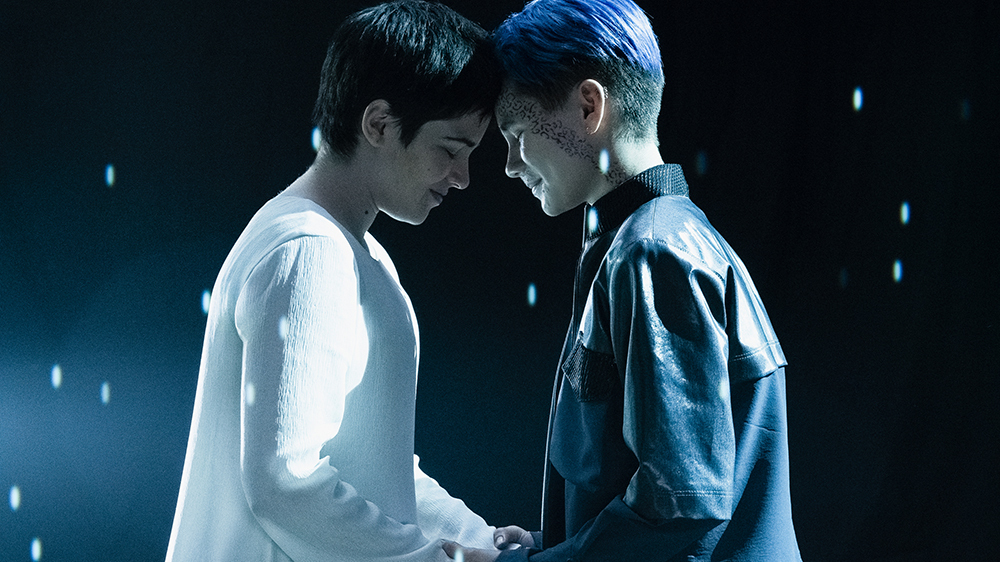How Star Trek: Discovery breached the gender binary
There are issues with how Star Trek: Discovery introduces its trans characters. But there’s also beauty.

This article contains spoilers for season 3 of Star Trek: Discovery.
It was not that long ago that, if you were a queer or trans person, there wasn’t a whole lot of reflection of yourself in popular culture, at least not in any positive or affirming sense. The refuge that many writers and viewers adopt — trying to relate a marginalized experience — is by using allegory. Star Trek has always been a bastion of smuggling progressive ideals (for their time) into high-concept science fiction adventures. However, just because something can be read to have symbolic meaning, doesn't mean that it functionally serves as one without caveats.
Take, for instance, the Trill and the symbionts, a pair of symbiotic races introduced in Deep Space Nine and most prominently portrayed by regular cast member Terry Farrell as Jadzia Dax. Symbionts are long-lived parasitic creatures who maintain their identity over the span of their Trill hosts’ lifetimes and the Trill gain the memories and experiences of the symbiont’s previous hosts. A Trill host may encounter people from the symbiont’s past life in a different host and be able to continue their relationships with minimal interruption, even though the Trill host still maintains a measure of their own personality.
In practice, this means that when characters interacted with Jadzia, the Trill host, for the first time since the symbiont Dax's previous male host had died, they would often have to recalibrate to Dax's new gender presentation, as the symbiont doesn't have its own sense of gender. Other characters’ casual self-correction of Dax’s pronouns and use of Jadzia’s name, as well as Jadzia’s memories of living as another gender, made the character something of a communal touchstone of transgender relatability for trans viewers. This was particularly notable considering the show aired in the 1990s and the go-to reference for transgender representation in media was the serial killer from Silence of the Lambs.
That said, it absolutely would be going too far to suggest that Star Trek was acting as a real representation of trans identity. Transgender people do not live literal multiple lives, nor do trans people exist as a merging of multiple personae into a cohesive whole. The only true way to represent a demographic in film and television is to actually bring that demographic into the creative process.
That’s why it’s so interesting to see Star Trek: Discovery attempt to bridge that gap between allegory and reality in its new season with the introduction of the non-binary human Adira (played by non-binary actor Blu del Barrio) and the trans Trill man Gray (played by trans actor Ian Alexander). To summarize the events of the latest episode, “Forget Me Not,” Adira reveals that they have merged with the symbiont Tal, an unprecedented occurrence for a human, but are unable to access memories the Discovery needs to continue its search for the remnants of Starfleet. The ship returns to the Trill homeworld, where the majority of the Trill leadership decries the human Adira as an abomination and refuses to help them. A dissenter surreptitiously helps them access a meditation pool where Adira is able to better commune with the symbiont’s past lives, forcing them to revisit traumatic memories of their boyfriend Gray’s death and the transfer of Tal into Adira.
It’s worth noting here that the introduction of Gray through their traumatic demise plays into an uncomfortable trend in queer storytelling where LGBTQ+ characters are often examined through their suffering. It’s a trope that reinforces the idea that queer and trans existence is inherently unhappy. Trans writer Riley Silverman already wrote a great article about why this is an issue, so I won’t belabor the point, but it complicates the more positive and radical message interwoven into the story, that focuses more on Adira’s role as Tal’s host.
Get the What to Watch Newsletter
The latest updates, reviews and unmissable series to watch and more!
Adira’s introduction in Star Trek: Discovery’s third episode is quietly revolutionary in how unremarkable it is. It would be perfectly in keeping with the progressive ideals of Federation society, 1,000 years in the future, to accept and normalize non-binary identity, but for the viewing audience, it's rare that a non-binary actor has played a non-binary character and that it's presented as not even worth comment. Admittedly, Adira’s non-binary identity could be made more explicit for those unfamiliar with Blu del Barrio or the show’s promotion of its progressive casting, but to make this dimension of trans experience explicit within Star Trek canon where only allegory was previously present is a massive step in the right direction.
This brings us back to the Trill. The previous generation of this franchise’s allegorical embodiment of queer experience, stripped of its specificity and amorphized into a non-human alien race. Adira’s status as a human who has merged with a symbiont is a threat to Trill self-identity, their holy and exclusive connection with the symbiont. If we take the Trill as the show’s previous personification of queerness, then it isn’t that much of a leap then to see Adira’s non-binary identity as a threat to established understanding of queer identity, a refutation against the sufficiency of allegory, and a statement of non-binary existence to those in the queer community that still reject it.
And the resolution of the episode would seem to uphold that reading as intentional. Adira is able to work through their repressed traumatic memories — again, a troubling way to introduce Gray, but here beside the point — and is able to reconnect with Tal’s past lives and the memories they contain. Adira connects with the history of the Trill, breaking down the illusion that they are different from one another simply because of their species and gaining the acceptance and embrace of the Trill leadership. In essence, the franchise that was previously restricted to allegory not only embraces a transgender representative but also signals that this all-too-human character marks a turning point to be celebrated.
It remains to be seen how Star Trek: Discovery will build upon this foundation. Both Blu del Barrio and Ian Alexander are cast regulars this season and the revelation that Gray lives within Adira offers the opportunity to address the character’s problematic introduction. But with respect to Adira, “Forget Me Not” is a pretty stunning evolution of Star Trek’s previous inadequacies. It feels good to be acknowledged as more than just a thought experiment. Blu del Barrio and Star Trek made me feel seen for who I am.
Leigh Monson has been a professional film critic and writer for six years, with bylines at Birth.Movies.Death., SlashFilm and Polygon. Attorney by day, cinephile by night and delicious snack by mid-afternoon, Leigh loves queer cinema and deconstructing genre tropes. If you like insights into recent films and love stupid puns, you can follow them on Twitter.











